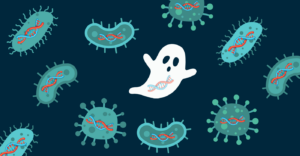DNA Wanted: Dead or Alive
What does “dead DNA” in the soil mean for Trace data?
Growers and agronomists have relied on traditional soil chemistry and fertility tests for decades to inform management of important soil nutrients like nitrogen, phosphorus, and potassium. While crucial to efficient and sustainable soil management, these tests fail to shed light on a major component of the soil environment: the microbiome. Living organisms like bacteria and fungi make up the soil microbiome and impact plant growth both indirectly (ex, improving soil structure) or directly (as pathogens or symbiotic microbes) (1). At Trace Genomics, we offer a way to illuminate the biological data hiding in soil that can be used to make smarter agronomic decisions.
Over the years, microbiologists have developed different methods for studying microorganisms in the environment. These techniques have advanced from laborious visual methods such as using a microscope to much faster molecular methods that evaluate biomolecules such as phospholipid fatty acids (PLFA) or DNA. Trace scientists use a comprehensive sequencing approach called metagenomics, which looks at all the DNA present in a soil sample. This is the only commercially-available* technique that can assess both which microbes are present in the soil as well as what soil functions they are able to perform. We are frequently asked: if you’re looking at all the DNA in the soil, does that include microbes that are dead?

The short answer is: yes, our process does sequence DNA from dead organisms. If the DNA is present in the soil sample, then we’re sequencing it.
The longer answer is: yes, but it doesn’t really matter. When a microbe dies, its “body” begins to break down. Once its DNA is free of the cell and released into the environment, it is called extracellular DNA (eDNA), relic DNA, or even dead DNA. Without the protection of a cell, eDNA has a high chance of decaying quickly. While eDNA can persist in the soil anywhere between a few weeks to a few years, the conditions in agricultural soils (high temperature and moisture) favor degradation (2). While an average of 40% of DNA in a soil sample can be eDNA (3), the pool of eDNA in a sample is generally representative of the living microbial population, so it does “not fundamentally alter estimates of microbial diversity” (4). At Trace, we provide contextual data for the abundance of microbes in the form of regional and national benchmarks. Because we’re comparing samples that all have eDNA, where an indicator falls in the distribution will remain the same.
*While metagenomics is the only commercially-available method for identifying soil microbes and their functions, another technique called metatranscriptomics is used by academic scientists to better understand which genes are active at a specific point in time. This technique is more difficult both in terms of sample collection (soil must immediately be placed on dry ice and kept frozen at -80C) and laboratory analysis (resulting in a much higher cost).
References
- Wang, X., Chi, Y., and Song, S. (2024). Important soil microbiota’s effects on plants and soils: a comprehensive 30-year systematic literature review. Frontiers in Microbiology 15. https://doi.org/10.3389/fmicb.2024.1347745.
- Bairoliya, S., Koh Zhi Xiang, J., and Cao, B. (2022). Extracellular DNA in Environmental Samples: Occurrence, Extraction, Quantification, and Impact on Microbial Biodiversity Assessment. Applied and Environmental Microbiology 88. https://doi.org/10.1128/aem.01845-21.
- Carini, P., Marsden, P.J., Leff, J.W., Morgan, E.E., Strickland, M.S., and Fierer, N. (2016). Relic DNA is abundant in soil and obscures estimates of soil microbial diversity. Nature Microbiology 2. https://doi.org/10.1038/nmicrobiol.2016.242.
- Lennon, J.T., Muscarella, M.E., Placella, S.A., and Lehmkuhl, B.K. (2018). How, When, and Where Relic DNA Affects Microbial Diversity. mBio 9. https://doi.org/10.1128/mbio.00637-18.
About the author: Dr. Tuesday Simmons is the Science Communication Manager at Trace Genomics. She earned her Ph.D. in Microbiology from the University of California, Berkeley, studying the root microbiome of cereal crops.



